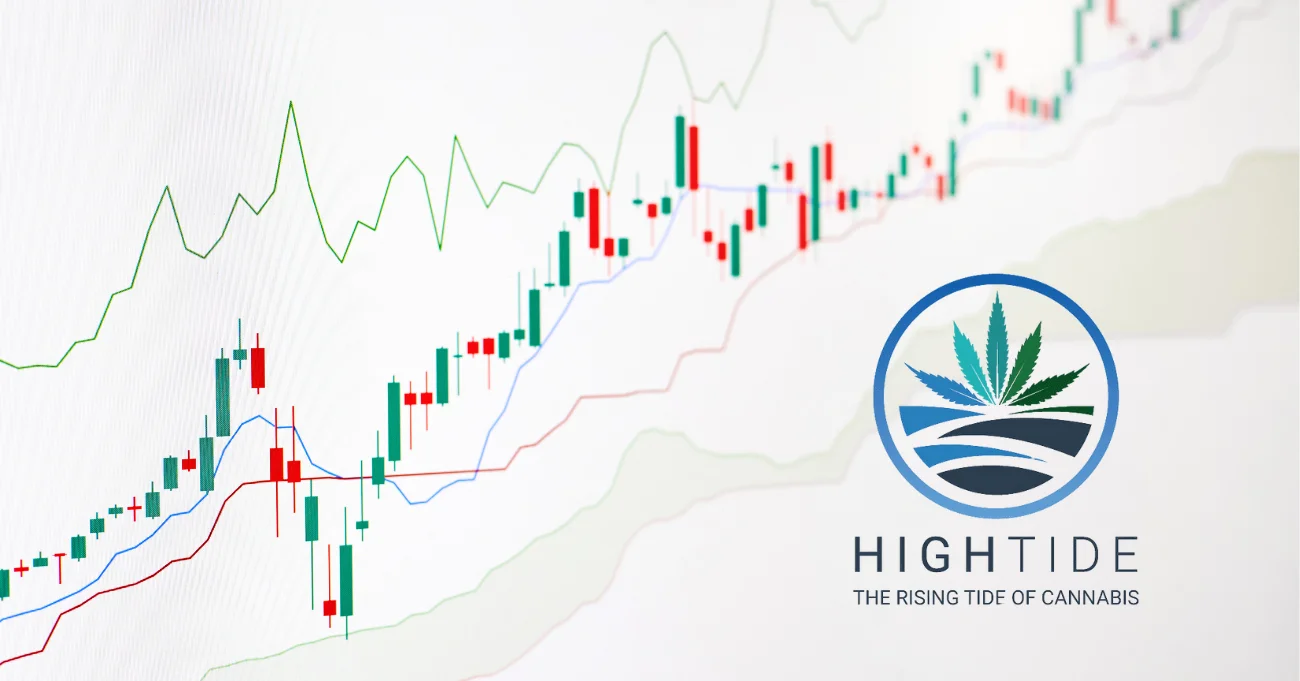
Investing in High Tide Stock: What You Need to Know
Investing in the stock market requires a good understanding of various stocks. High Tide stock (HITI) is a compelling option, particularly due to its expanding presence in Canada, promising market cap, and steady growth. However, before making any investment decisions, it’s crucial to understand key metrics such as the PEG ratio and beta.
At Spartan Trading, we provide insights that help investors navigate the complexities of the market. We focus on delivering actionable ideas based on in-depth research. Our team has conducted a comprehensive analysis of HITI stock, considering its performance, results, and future earnings. We believe that a well-informed approach empowers investors to make better decisions.
Given our comprehensive analysis, we’ve created this guide to explore HITI stock in detail. This blog covers everything from the company’s background to its stock performance, including market cap, PEG, and EBITDA metrics. By the end of this blog, you’ll clearly understand whether High Tide stock fits your investment goals.
Let’s dive in!
High Tide Inc. (HITI): Company and Stock Overview

High Tide Inc. is a leading cannabis retailer and manufacturer that focuses on providing high-quality products in various segments, including accessories and e-commerce. High Tide operates through multiple subsidiaries, solidifying its market presence. Listed on the Nasdaq, High Tide continues to grow, reflecting its commitment to expanding in the cannabis industry.
High Tide stock (HITI) has attracted investor attention due to its strong performance. With a focus on profitability, the stock shows promise through its EPS (Earnings Per Share) growth. Recent earnings reports highlight the company’s robust performance in TTM (Trailing Twelve Months) and MRQ (Most Recent Quarter). Analysts provide optimistic EST (estimates) for the stock’s future, underlining its potential in the market. As HITI stock continues to evolve, it remains a compelling option for investors.
HITI (High Tide) Stock Performance and Analysis
High Tide Inc. (HITI) is a rapidly growing retail-focused cannabis company with a strong presence in Canada and the U.S. Let’s explore the High Tide stock performance, growth potential, and market position, providing investors with insights into its financial health and prospects in the cannabis industry.

1. Market Position and Capitalization
With a market capitalization of approximately $155.34 million, High Tide holds a notable position within the industry. The company’s enterprise value of $181.11 million reflects its broader market presence and future potential. High Tide competes with other cannabis companies in a rapidly evolving market where legalization trends and consumer acceptance play crucial roles. The company’s strategic positioning significantly allows it to leverage growth opportunities as the cannabis industry expands globally.
2. Financial Position
The financial health of High Tide stock is crucial in evaluating investment appeal. Key financial ratios provide a snapshot of the company’s ability to manage its assets, liabilities, and overall financial stability.
- Current Ratio: High Tide maintains a current ratio of 1.17, indicating that it has slightly more current assets than current liabilities. This suggests that the company can cover its short-term obligations with limited cushion.
- Quick Ratio: The quick ratio, excluding inventory from current assets, stands at 0.64. This lower ratio reflects the company’s reliance on inventory, which is typical in retail but may pose risks if inventory cannot be quickly converted into cash.
- Debt / Equity Ratio: A debt-to-equity ratio of 0.48 indicates that High Tide has a balanced approach to leveraging, with less than half of its capital structure composed of debt. This ratio shows a relatively low level of risk concerning debt management.
- Debt / EBITDA: High Tide’s debt-to-EBITDA ratio is 2.05, suggesting the company generates sufficient earnings before interest, taxes, depreciation, and amortization to cover its debt. This reflects a moderate risk level and efficient debt management.
- Debt / FCF: The debt-to-free cash flow ratio of 2.25 indicates that High Tide’s free cash flow is adequate to manage its debt, ensuring financial flexibility.
- Interest Coverage: With an interest coverage ratio of 0.76, High Tide struggles to cover its interest expenses from operating profits. This ratio suggests the company may face challenges maintaining its current debt levels if profitability does not improve.
High Tide’s financial position demonstrates manageable debt levels and adequate liquidity. However, the low-interest coverage ratio highlights potential concerns regarding the company’s ability to sustain its debt obligations in the long term.
3. Valuation Ratios
Valuation ratios help investors determine if High Tide stock is fairly priced. These ratios provide insights into the stock’s valuation relative to its earnings, sales, and other financial metrics.
- PE Ratio: High Tide does not have a meaningful PE ratio due to negative earnings. This absence of a PE ratio makes it difficult to assess the stock’s value based on earnings alone.
- Forward PE: The forward PE ratio of 140.00 suggests high expectations for future earnings growth. However, this high ratio also indicates that the stock may be overvalued based on current earnings projections.
- PS Ratio: The price-to-sales (PS) ratio is not available for High Tide, limiting the analysis of the stock’s value relative to its sales.
- Forward PS: With a forward PS ratio of 0.40, investors pay less than half a dollar for each dollar of expected future sales, suggesting potential undervaluation if growth materializes.
- PB Ratio: The price-to-book (PB) ratio is not available, but typically, this ratio helps evaluate the stock’s price relative to its book value. Without this data, assessing the stock’s intrinsic value becomes more challenging.
- P/FCF Ratio: The price-to-free cash flow (P/FCF) ratio of 7.09 indicates that investors are paying $7.09 for every dollar of free cash flow generated, which is relatively attractive. This suggests that the stock is not overvalued based on cash flow.
- PEG Ratio: The PEG ratio, which considers growth relative to price, is unavailable. Considering its growth prospects, this metric often helps determine whether a stock is over or undervalued.
High Tide’s valuation ratios reveal a complex picture. While the high forward PE ratio indicates optimism about future earnings, the absence of meaningful PE and PB ratios complicates a straightforward valuation. The attractive P/FCF ratio, however, hints that the stock might be a good buy for those focused on cash flow.
4. Stock Grade
High Tide Stock receives various grades that reflect its performance across four key areas: value, growth, quality, and momentum. These criteria provide a holistic view of the stock’s investment potential.
- Value Grade: High Tide stock scores well on value, with a deep value grade of 85. This high-value grade indicates that the stock may be undervalued relative to its fundamentals, presenting an attractive entry point for value investors.
- Growth Grade: HITI stock’s growth grade is 71, highlighting strong sales growth and positive cash flow trends. This grade underscores the company’s potential for expansion, driven by increasing market share in the cannabis sector.
- Quality Grade: HITI stock has a moderate quality grade, reflecting average returns on assets and capital. While the company shows potential, operational efficiency could improve, particularly in generating consistent profitability.
- Momentum Grade: With a momentum grade of 70, High Tide stock exhibits strong price performance relative to the market. This suggests that investor sentiment is positive, with the stock likely benefiting from recent trends and growth expectations.
High Tide stock demonstrates strong value and growth characteristics, supported by positive momentum. However, investors should consider the quality metrics, which suggest room for operational improvements.
5. Dividend Yield
High Tide stock currently does not offer a dividend yield. This reflects the company’s focus on reinvesting profits into growth initiatives rather than returning cash to shareholders. While this may be a drawback for income-focused investors, those seeking capital appreciation may find the HITI stock growth potential more appealing.
Key Drivers of HITI (High Tide) Stock Growth and Performance
Understanding the factors driving High Tide stock is crucial for investors. High Tide operates in the cannabis industry, and its growth potential hinges on various internal and external factors. Here, we explore the key drivers that influence High Tide stock performance.

1. Cannabis Industry Growth
The legal cannabis market has experienced significant expansion, and High Tide stock benefits directly from this trend. As more regions legalize cannabis, demand increases, leading to higher revenues for companies like High Tide. The company’s extensive retail presence allows it to capitalize on this growing market.
2. Strategic Acquisitions
High Tide has aggressively pursued acquisitions to expand its footprint and diversify its product offerings. These strategic moves have positioned High Tide stock favorably in a competitive market. Each acquisition enhances the company’s market share and contributes to revenue growth, which investors view positively.
3. E-commerce and Digital Sales
The shift towards e-commerce has accelerated, and High Tide has leveraged this trend. The company’s online platforms generate additional revenue, especially in markets where physical stores face restrictions. This digital growth has significantly driven High Tide stock performance, attracting investors looking for innovative business models.
4. Regulatory Environment
Changes in cannabis regulation directly impact High Tide stock. Favorable regulatory shifts, such as legalization or decriminalization, create new opportunities for market expansion, and High Tide remains well-positioned to adapt to these changes.
5. Financial Stability and Cash Flow
High Tide’s solid financial position, stable cash flow, and manageable debt levels have reassured investors about HITI stock’s potential for growth. A strong balance sheet provides the foundation for sustainable growth and continued market presence.
High Tide (HITI) Similar Stocks and Competitors
Investors interested in High Tide stock (HITI) often look at similar companies in the cannabis industry to compare performance, growth potential, and market position. Here are three stocks considered close competitors or similar in business model and market focus.
1. Curaleaf Holdings Inc. (CURLF) Stock

Curaleaf Holdings Inc. is a major player in the cannabis industry, operating dispensaries and cultivation sites across North America. The company produces and distributes various cannabis products, with a strong emphasis on innovation and quality. Its headquarters are in Wakefield, Massachusetts, where it continues expanding its reach and influence.
CURLF stock represents Curaleaf’s growth potential within the ever-evolving cannabis sector. Despite recent challenges, the stock has shown resilience, with analysts maintaining a cautious yet optimistic outlook. Investors closely watch CURLF’s performance, noting its market position and potential for long-term gains.
CURLF Stock Performance
- Market Position and Capitalization: Curaleaf holds a strong market position with a market cap of $2.39 billion, reflecting its influence in the cannabis industry.
- Financial Position: With a current ratio of 1.09, the company exhibits a stable capacity to meet short-term liabilities.
- Valuation Ratios: The stock presents a moderately valued opportunity with an EV/EBITDA ratio of 13.89.
- Stock Grade: Despite challenges, CURLF exhibits growth potential, though it remains speculative.
- Dividend Yield: Currently, the stock does not pay dividends, focusing instead on reinvestment for growth.
CURLF Stock exposes the growing cannabis sector, but potential investors should weigh the financial risks. The stock’s performance reflects both opportunities and challenges inherent in the industry. Careful analysis and a long-term perspective remain crucial when considering this investment.
2. Trulieve Cannabis Corp. (TCNNF) Stock

Trulieve Cannabis Corp. is a prominent player in the cannabis industry, producing and distributing cannabis products throughout the United States. Based in Tallahassee, Florida, the company has adopted a vertical integration strategy, maintaining control over all aspects of its operations, from cultivation to retail sales.
TCNNF stock offers investors a stake in Trulieve’s growing influence within the cannabis sector. Despite some financial setbacks, the stock has demonstrated strong resilience, with a notable increase in its market price over the past year. Analysts view TCNNF with a strong buy consensus, indicating confidence in its future growth prospects.
TCNNF Stock Performance
- Market Position and Capitalization: Trulieve maintains a solid market position, with a market capitalization of $1.80 billion, reflecting its stability and growth potential in the cannabis industry.
- Financial Position: The company boasts a strong current ratio of 5.10, indicating robust liquidity and the ability to meet short-term obligations.
- Valuation Ratios: An EV/EBITDA ratio of 7.14 suggests the stock is reasonably valued and offers potential growth at a fair price.
- Stock Grade: Despite challenges, TCNNF displays solid financial health and growth potential, making it an attractive option for investors.
- Dividend Yield: TCNNF does not offer dividends but focuses on reinvestment and growth strategies.
TCNNF Stock provides exposure to a leading cannabis company with significant market growth. However, potential investors should consider the inherent risks within the cannabis industry. Thorough research and a long-term investment outlook are essential for those looking to capitalize on Trulieve’s potential.
3. Green Thumb Industries Inc. (GTBIF) Stock

Green Thumb Industries Inc. is a leading cannabis consumer packaged goods company headquartered in Chicago. The company owns popular brands like RYTHM and Dogwalkers and focuses on delivering high-quality cannabis products to a growing market. Boasting a significant presence across multiple states, Green Thumb has firmly established itself as a major player in the U.S. cannabis industry.
GTBIF stock reflects the company’s growth in the evolving cannabis sector, drawing attention due to its solid financials and strategic positioning. Investors view GTBIF as a compelling opportunity driven by its consistent revenue growth and market expansion.
GTBIF Stock Performance
- Market Position and Capitalization: GTBIF commands a strong market position with a $2.51 billion market cap, highlighting its influence in the cannabis space.
- Financial Position: The company’s current ratio is 1.09, demonstrating adequate short-term liquidity, and a debt/equity ratio of 0.33 suggests a conservative leverage approach.
- Valuation Ratios: An EV/EBITDA ratio of 8.58 indicates a moderate valuation relative to earnings.
- Stock Grade: The stock enjoys high momentum and value grades, reflecting its robust market performance.
- Dividend Yield: GTBIF currently reinvests profits for growth, with no dividends offered to shareholders.
GTBIF Stock offers potential exposure to the burgeoning cannabis market. The company’s strong market position and strategic growth initiatives attract investors seeking long-term gains. However, investors should consider the inherent risks in the cannabis industry when evaluating this stock.
Key Takeaway
Investors exploring High Tide Stock should focus on its unique positioning in the cannabis market and evaluate how it aligns with their financial goals. The stock’s growth potential, influenced by the expanding cannabis industry, presents opportunities for those with high risk tolerance. Tools like the Finviz Screener and TradingView Stock Heatmap offer valuable insights, enabling investors to track HITI stock and stay informed on market trends.
Before making decisions, consider whether HITI stock complements your overall investment strategy. Utilize resources such as an option trade journal to record and review your trades, helping refine your approach over time. This disciplined method can lead to more informed decisions and better long-term results.
Are you ready to dive deeper into your investment journey with High Tide stock? At Spartan Trading, we provide expert guidance tailored to your needs. Join our community today and stay ahead of the market. Subscribe to our newsletter for regular updates and actionable insights to boost your trading success.



